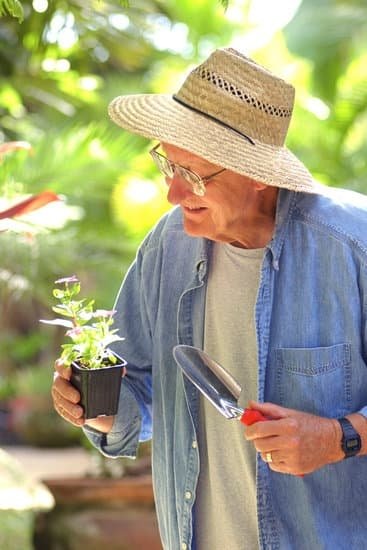Are you eager to start a garden but feeling overwhelmed by the thought of complex gardening techniques? In this article, we will explore simple gardening ideas that anyone can implement to create a beautiful and thriving garden.
Whether you are new to gardening or simply looking for easy and practical tips, we’ve got you covered. From choosing the right plants to efficient watering and low-cost DIY projects, these simple gardening ideas will help you embrace simplicity in your gardening journey.
When it comes to creating a low-maintenance garden, choosing the right plants is key. We’ll discuss how to select plants that require minimal care and are well-suited for your specific growing conditions. Additionally, we’ll explore creative container gardening options for those with limited space, as well as provide tips on efficient watering and irrigation to ensure your garden thrives without requiring constant attention.
In addition, we will delve into practical pest control and natural remedies, as well as low-cost DIY garden projects that add charm and functionality to your outdoor space. Furthermore, we’ll take a look at maximizing space with vertical gardening and provide seasonal care and maintenance tips for a bountiful harvest all year round.
Overall, our goal is to help simplify the gardening process so that anyone can enjoy the beauty of a lush and vibrant garden without feeling overwhelmed.
Choosing the Right Plants for Easy Maintenance
When it comes to creating a low-maintenance garden, one of the most important factors to consider is choosing the right plants. Opting for plants that are well-suited to your local climate and soil conditions can make a significant difference in the amount of time and effort required to keep your garden looking its best.
One simple gardening idea is to select native or drought-tolerant plants that require minimal watering and care. These types of plants are well-adapted to the local environment and can thrive with little intervention, making them an excellent choice for those looking to minimize maintenance tasks in their garden.
Another approach to easy plant maintenance is to choose species that are known for their disease resistance and resilience against pests. By selecting plants with these qualities, you can reduce the need for chemical treatments and interventions, promoting a healthier and more sustainable garden environment.
In addition, incorporating perennial plants into your garden design can also contribute to easier maintenance. Perennials typically require less attention compared to annuals, as they return year after year with minimal effort on the part of the gardener. By carefully considering the plant selection for your garden, you can set yourself up for a beautiful and low-maintenance outdoor space that brings joy without consuming too much time and energy.
Creative Container Gardening for Limited Spaces
One of the most popular and effective simple gardening ideas for those with limited space is container gardening. This method allows individuals to grow plants in pots, hanging baskets, or other containers, making it perfect for small urban spaces, balconies, or even indoor gardens. The key to successful container gardening is choosing the right plants for the available space and ensuring proper care and maintenance.
When selecting plants for container gardening, it’s essential to consider the available sunlight, space constraints, and the environment. For small spaces, herbs like basil, parsley, or chives are excellent options that can thrive in containers. Flowers like petunias, marigolds, or pansies also do well in limited spaces and can add a pop of color to any area.
In addition to choosing the right plants, creative container gardening also involves thinking outside of traditional pots. Consider using repurposed items such as old watering cans, wooden crates, or even mason jars for a unique and visually appealing garden display. With some creativity and resourcefulness, even the smallest of spaces can be transformed into a beautiful container garden oasis.
| Plants | Container Type |
|---|---|
| Basil | Pots |
| Petunias | Hanging Baskets |
| Chives | Repurposed Items (e.g. mason jars) |
Efficient Watering and Irrigation Tips
When it comes to maintaining a garden, one of the most important aspects to consider is efficient watering and irrigation. Proper watering not only ensures the health and vitality of your plants, but it also contributes to water conservation and overall garden sustainability. Here are some simple gardening ideas for efficient watering and irrigation that can help you achieve a thriving garden while being mindful of water usage.
First, consider investing in a soaker hose or drip irrigation system. These systems deliver water directly to the base of your plants, minimizing evaporation and runoff. This targeted approach ensures that the roots receive the necessary moisture without wasting water in areas where it’s not needed. Additionally, these methods can save you time as they require less frequent watering than traditional methods.
Another simple watering tip is to water your garden in the morning or late afternoon to reduce evaporation. By avoiding midday watering when the sun is strongest, you can ensure that more water reaches the plants’ roots instead of being lost to evaporation. Furthermore, using a layer of mulch around your plants helps retain soil moisture, reducing the need for frequent watering.
To further maximize water efficiency in your garden, consider collecting rainwater in barrels or installing a greywater system for irrigating your plants. Utilizing these alternative water sources reduces your reliance on treated tap water while providing a sustainable way to keep your garden hydrated.
Lastly, incorporating drought-tolerant plants into your garden design can significantly reduce the need for excessive watering. Native plants and succulents are good options for low-maintenance landscaping that requires minimal irrigation.
| Watering Tip | Description |
|---|---|
| Invest in Soaker Hoses or Drip Irrigation | Deliver water directly to plant roots, minimize evaporation and runoff. |
| Mulching | Use mulch to retain soil moisture and reduce frequency of watering. |
Practical Pest Control and Natural Remedies
Pests can wreak havoc on a garden, but there are simple and effective ways to control them using natural remedies. By employing these methods, you can keep your garden healthy and thriving without the use of harsh chemicals that may harm beneficial insects or pose risks to human health.
Companion Planting and Natural Predators
One of the simplest and most effective ways to control pests in the garden is through companion planting. Some plants naturally repel insects, while others attract beneficial insects that feed on pests. For example, planting marigolds around your vegetable garden can deter nematodes, while attracting ladybugs can help control aphids. By incorporating these plants into your garden design, you can reduce the need for chemical pest control.
Homemade Pest Sprays and Traps
Another natural approach to pest control is making homemade sprays and traps using common household ingredients. For instance, a mixture of water, dish soap, and cayenne pepper can be used to deter pests like aphids and caterpillars. Beer traps can also be effective in controlling slugs and snails. These simple remedies are not only effective but also safe for the environment.
Maintaining a Healthy Garden
Finally, one of the best methods for controlling pests is to maintain a healthy garden ecosystem. Keep your plants well-watered and fertilized, as healthy plants are better able to resist pest infestations. Regularly inspect your plants for signs of damage or infestation so that you can address any issues early on. By taking a proactive approach to garden maintenance, you can minimize the impact of pests without resorting to chemical solutions.
By incorporating practical pest control and natural remedies into your gardening routine, you can create a thriving and sustainable garden that is both beautiful and bountiful. These simple gardening ideas empower you to embrace simplicity in maintaining the health of your garden while minimizing environmental impact.
Low-Cost DIY Garden Projects
Gardening can be a rewarding and fulfilling hobby, but it doesn’t have to break the bank. In fact, there are plenty of low-cost DIY garden projects that can help you create a beautiful and functional outdoor space without spending a fortune. Whether you’re looking to add some personality to your garden or simply want to make the most of your outdoor space, these simple gardening ideas will inspire you to get creative without breaking the bank.
Upcycled Planters and Containers
One of the easiest and most cost-effective ways to add interest to your garden is by upcycling old items into planters and containers. From old tires and wooden pallets to tin cans and mason jars, there are countless items that can be repurposed into unique planters for your flowers, herbs, and vegetables. Not only will this save you money, but it’s also a great way to reduce waste and add a personal touch to your garden.
DIY Garden Décor
Another budget-friendly way to spruce up your outdoor space is by creating your own garden decor. Whether it’s homemade stepping stones, hand-painted signs, or colorful wind chimes, adding some DIY elements to your garden can help personalize your space while adding a touch of creativity. You can even get the whole family involved in creating these decorations, making it a fun and memorable project for everyone.
Composting and Mulching
Creating your own compost bin or mulching system is not only an affordable option for enriching your soil and reducing waste but also a sustainable approach to gardening. By using kitchen scraps such as fruit peels, eggshells, coffee grounds, and yard waste like leaves and grass clippings, you can create nutrient-rich compost that will improve the health of your plants while minimizing the need for chemical fertilizers.
Similarly, mulching with organic materials like straw or wood chips helps retain moisture in the soil, suppress weeds, and regulate soil temperature – all at little to no cost.
Maximizing Space With Vertical Gardening
Vertical gardening is a great way to make the most of limited space, whether you have a small backyard, balcony, or even just a sunny wall. With these simple gardening ideas, you can maximize your growing area and add visual interest to your outdoor space.
To get started with vertical gardening, consider the following tips:
- Choose the Right Plants: Opt for vining plants like tomatoes, cucumbers, and beans that naturally grow upwards.
- Utilize Vertical Structures: Install trellises, arbors, or hanging planters to support your plants and create a vertical garden display.
- Consider Vertical Hydroponic Systems: If space is really at a premium, consider setting up a vertical hydroponic system that allows you to grow plants without soil in a compact vertical setup.
Efficient use of space is not the only benefit of vertical gardening. It also helps improve air circulation and light exposure for your plants. Plus, it can be an attractive addition to your outdoor decor.
When practicing vertical gardening in limited spaces such as balconies or urban areas, be sure to check any local zoning regulations regarding outdoor structures. Once you have the green light to proceed with your plans, implementing these simple gardening ideas will transform any small space into a thriving garden oasis.
Seasonal Care and Maintenance for a Thriving Garden
As the seasons change, it is crucial to adapt your gardening routine to ensure that your garden continues to thrive. With a few simple gardening ideas, you can keep your plants healthy and productive all year round.
First and foremost, it’s important to understand the specific needs of your plants during each season. Whether it’s providing extra water and shade during the scorching summer months or protecting delicate plants from frost in the winter, being in tune with the seasonal requirements of your garden is essential for its success.
To help you stay organized and on top of seasonal care for your garden, here are some practical tips:
- Spring: This is the time to clean up any debris left over from winter, prepare the soil, and start planting new seeds or seedlings. It’s also a good time to prune any dead branches or overgrown shrubs.
- Summer: In hot weather, make sure to water your plants deeply but infrequently to encourage strong root growth. Consider using mulch to retain moisture and protect roots from heat stress.
- Fall: As temperatures cool down, focus on harvesting fruits and vegetables, as well as planting fall crops such as lettuce and kale. It’s also a great time to divide perennials and tidy up the garden beds.
- Winter: Protect tender plants from freezing temperatures by covering them with blankets or bringing them indoors. Use this time for planning next year’s garden layout and ordering seeds or supplies.
By following these simple seasonal care tips, you can ensure that your garden remains healthy and vibrant throughout the year without feeling overwhelmed by maintenance tasks. Embracing simplicity in gardening can lead to a beautiful and bountiful harvest.
Conclusion
In conclusion, embracing simple gardening ideas is the key to achieving a beautiful and bountiful harvest while minimizing the time and effort spent on maintenance. By choosing the right plants for easy maintenance, utilizing creative container gardening for limited spaces, and implementing efficient watering and irrigation tips, gardeners can create a thriving garden with minimal hassle.
Additionally, practical pest control and natural remedies, low-cost DIY garden projects, maximizing space with vertical gardening, and seasonal care and maintenance all contribute to a successful and sustainable garden.
It’s important to remember that gardening doesn’t have to be complicated or overwhelming. In fact, by focusing on simple gardening ideas, individuals can experience the joys of growing their own food and creating a beautiful outdoor space without feeling stressed or burdened by excessive maintenance. Whether you’re a beginner or experienced gardener, incorporating these simple techniques can make a significant difference in the overall success of your garden while allowing you to enjoy the process more fully.
In essence, simplicity is at the core of successful gardening. By using these simple gardening ideas as a foundation for your gardening efforts, you can save time and money while still reaping the rewards of a vibrant and flourishing garden. So whether you have limited space or are working with a tight budget, implementing these tips will help you achieve a stunning garden that brings joy and satisfaction throughout the seasons.
Frequently Asked Questions
What Should I Garden for Beginners?
For beginners, it’s best to start with easy-to-grow plants like tomatoes, lettuce, and herbs. These are relatively low-maintenance and can be grown in containers or small plots. Starting with simple crops will help you gain confidence and experience in gardening.
How Do You Make a Simple Garden?
Making a simple garden involves choosing a sunny spot, preparing the soil by adding compost or fertilizer, selecting easy-to-grow plants, and planting them accordingly. Regular watering and occasional weeding will help your garden thrive without too much effort.
How Do You Layout a Garden for Beginners?
When laying out a garden for beginners, it’s important to consider the sunlight exposure and water drainage of the area. Start with a simple design, placing taller plants at the back and shorter ones in the front for easy access.
Leave enough space between plants for proper growth and airflow. As you gain more experience, you can experiment with more complex layouts and designs.

Welcome to my gardening blog! I am passionate about plants and enjoy sharing my knowledge and experiences with others. In this blog, I will write about everything related to gardening, from tips on how to get started to updates on my own garden projects.





